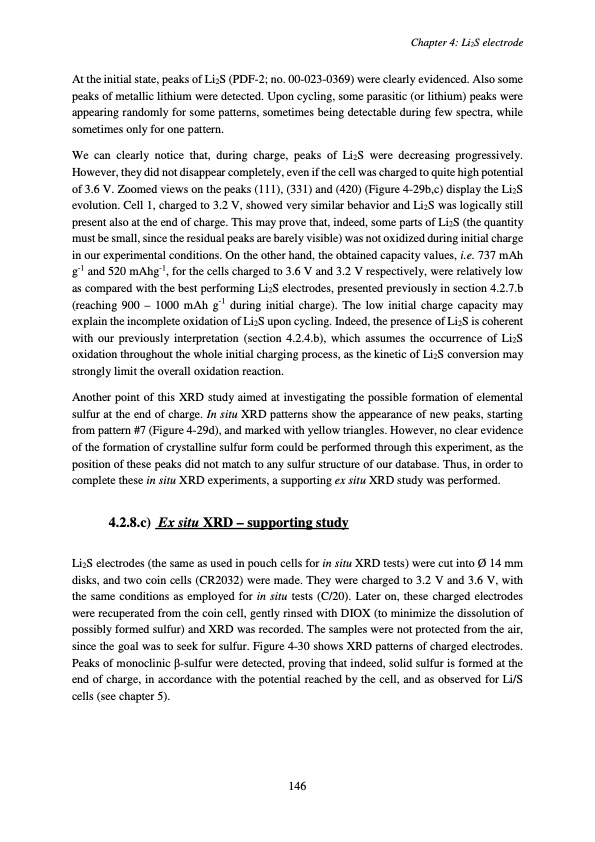
PDF Publication Title:
Text from PDF Page: 150
At the initial state, peaks of Li2S (PDF-2; no. 00-023-0369) were clearly evidenced. Also some peaks of metallic lithium were detected. Upon cycling, some parasitic (or lithium) peaks were appearing randomly for some patterns, sometimes being detectable during few spectra, while sometimes only for one pattern. We can clearly notice that, during charge, peaks of Li2S were decreasing progressively. However, they did not disappear completely, even if the cell was charged to quite high potential of 3.6 V. Zoomed views on the peaks (111), (331) and (420) (Figure 4-29b,c) display the Li2S evolution. Cell 1, charged to 3.2 V, showed very similar behavior and Li2S was logically still present also at the end of charge. This may prove that, indeed, some parts of Li2S (the quantity must be small, since the residual peaks are barely visible) was not oxidized during initial charge in our experimental conditions. On the other hand, the obtained capacity values, i.e. 737 mAh g-1 and 520 mAhg-1, for the cells charged to 3.6 V and 3.2 V respectively, were relatively low as compared with the best performing Li2S electrodes, presented previously in section 4.2.7.b (reaching 900 – 1000 mAh g-1 during initial charge). The low initial charge capacity may explain the incomplete oxidation of Li2S upon cycling. Indeed, the presence of Li2S is coherent with our previously interpretation (section 4.2.4.b), which assumes the occurrence of Li2S oxidation throughout the whole initial charging process, as the kinetic of Li2S conversion may strongly limit the overall oxidation reaction. Another point of this XRD study aimed at investigating the possible formation of elemental sulfur at the end of charge. In situ XRD patterns show the appearance of new peaks, starting from pattern #7 (Figure 4-29d), and marked with yellow triangles. However, no clear evidence of the formation of crystalline sulfur form could be performed through this experiment, as the position of these peaks did not match to any sulfur structure of our database. Thus, in order to complete these in situ XRD experiments, a supporting ex situ XRD study was performed. 4.2.8.c) Ex situ XRD – supporting study Li2S electrodes (the same as used in pouch cells for in situ XRD tests) were cut into Ø 14 mm disks, and two coin cells (CR2032) were made. They were charged to 3.2 V and 3.6 V, with the same conditions as employed for in situ tests (C/20). Later on, these charged electrodes were recuperated from the coin cell, gently rinsed with DIOX (to minimize the dissolution of possibly formed sulfur) and XRD was recorded. The samples were not protected from the air, since the goal was to seek for sulfur. Figure 4-30 shows XRD patterns of charged electrodes. Peaks of monoclinic β-sulfur were detected, proving that indeed, solid sulfur is formed at the end of charge, in accordance with the potential reached by the cell, and as observed for Li/S cells (see chapter 5). Chapter 4: Li2S electrode 146PDF Image | Accumulateur Lithium Soufre

PDF Search Title:
Accumulateur Lithium SoufreOriginal File Name Searched:
WALUS_2015_archivage.pdfDIY PDF Search: Google It | Yahoo | Bing
Sulfur Deposition on Carbon Nanofibers using Supercritical CO2 Sulfur Deposition on Carbon Nanofibers using Supercritical CO2. Gamma sulfur also known as mother of pearl sulfur and nacreous sulfur... More Info
CO2 Organic Rankine Cycle Experimenter Platform The supercritical CO2 phase change system is both a heat pump and organic rankine cycle which can be used for those purposes and as a supercritical extractor for advanced subcritical and supercritical extraction technology. Uses include producing nanoparticles, precious metal CO2 extraction, lithium battery recycling, and other applications... More Info
| CONTACT TEL: 608-238-6001 Email: greg@infinityturbine.com | RSS | AMP |